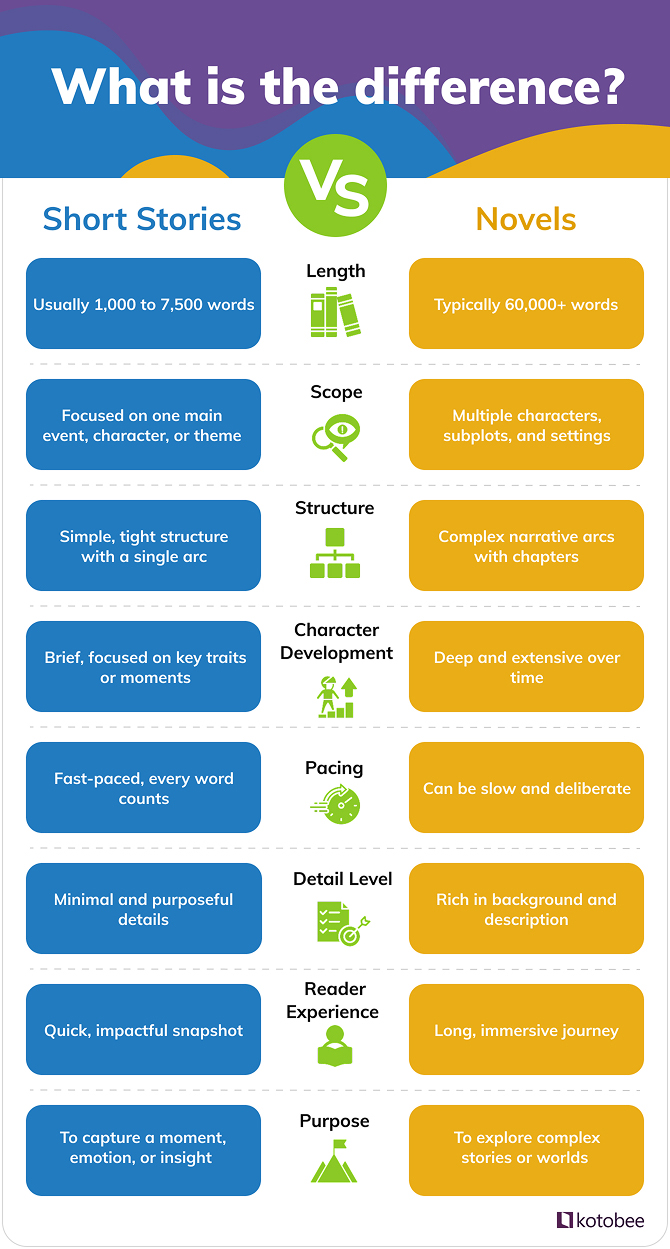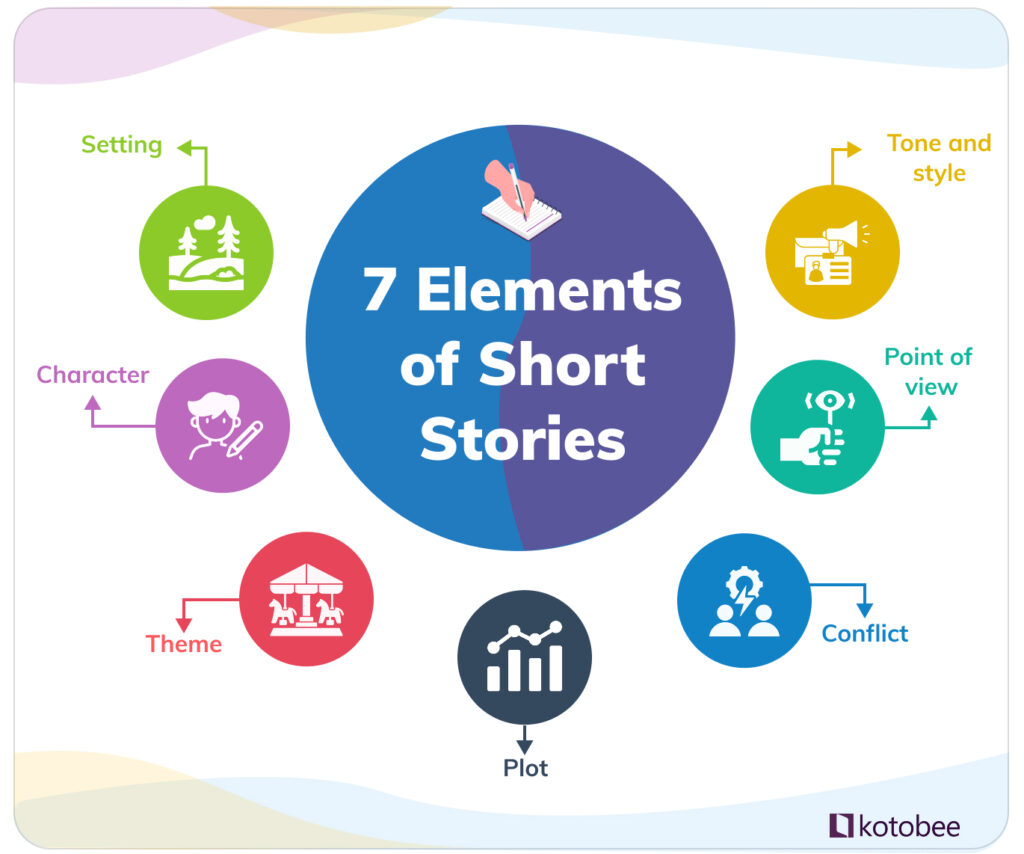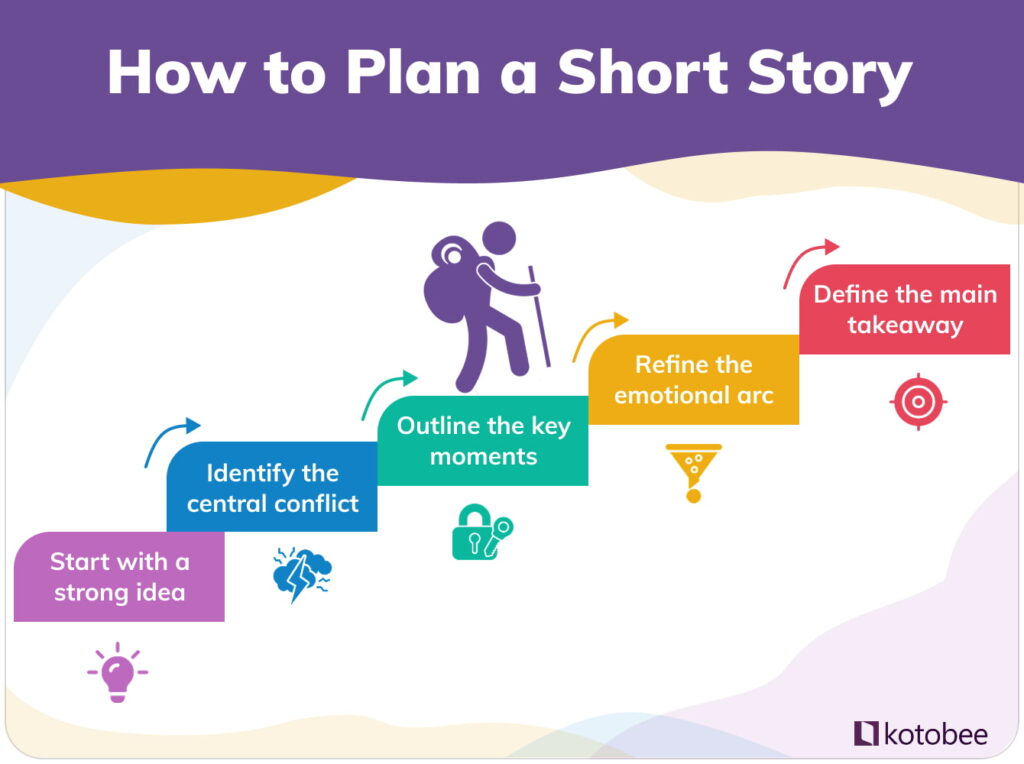Short stories pack a punch in just a few pages. With limited space, every detail has to count, including each word, scene, and character. There’s no room for lengthy descriptions or distractions. And that’s what makes them both challenging to write yet powerful in their impact on the readers. That’s because they can capture emotion, spark ideas, and leave a lasting impression, all in a matter of minutes.
So, what makes short stories so impactful? The secret lies in a few key ingredients; when carefully combined, these ingredients can turn even the simplest idea into a narrative that sticks with your reader. To learn how to achieve that, keep reading this article as we explore the different elements of a short story and how they work together to shape a memorable tale.

Short Stories vs Novels: What Is the Difference?
Before we go into the main elements of short stories, let’s quickly review how this literary format differ from novels (other than in length, of course). Understanding these differences can help you decide which form best suits the story you want to tell and how to approach your writing accordingly.
While both short stories and novels tell compelling tales, they differ greatly in scope, structure, and purpose. Novels have the space to develop complex plots, multiple characters, and detailed worlds. They have room for subplots, backstories, and gradual character growth.
Short stories, on the other hand, demand brevity and precision. They focus on a single moment, character, or idea, often capturing a slice of life or a pivotal event. And because of this limited space, they rely on strong imagery, carefully chosen words, and sharp structure.
Here’s a side-by-side comparison to highlight the main differences between these two literary forms:

The Main 7 Elements of a Short Story
Every great short story, no matter its style or subject, is built on seven key elements. These essential ingredients work together to create a focused, compelling narrative that draws readers in and keeps them engaged. Mastering these elements will help you craft stories that feel complete and powerful, even within a limited number of pages.
1. Setting
The setting of a short story is the time and place where the events unfold. It’s more than just a backdrop; it shapes the mood, influences the characters’ actions, and helps immerse the reader in the story’s world. Because short stories have limited space, the setting needs to be established quickly but effectively, using precise and vivid details that evoke a strong sense of the overall atmosphere.
Whether your story takes place in a crowded city, a quiet village, or an otherworldly realm, the setting you choose has to provide context and anchor your reader. It can also reflect or contrast with the story’s themes, thereby deepening the impact. Just remember when crafting your setting to focus on details that matter most to your plot and characters. You might also need to use sensory descriptions (such as auditory or visual details) to bring the scene to life without overwhelming the narrative.
Take the setting of Edgar Allan Poe’s The Tell-Tale Heart, for example. The story takes place at night (time), inside a dim, quiet house (place), where the stillness and darkness create an atmosphere of dread. The air feels heavy, and every creak or whispered breath seems amplified in the surrounding silence, pulling the reader deeper into the tension (sensory description). Additionally, Poe draws readers into a tense, claustrophobic space where the old man’s bedroom becomes the stage for obsession and guilt. The silence and shadows of the night heighten the suspense and echo the story’s haunting themes.
💡Pro writing tip: Choose 2–3 vivid sensory details (a sound, a smell, a texture) that instantly place the reader in your story’s world. Use these early to ground the scene without overloading the paragraph.
2. Characters
Characters are the driving force behind every short story. With limited space, most short stories focus on just one or two characters, but those characters still need to feel real. It’s their goals, fears, and choices that move the story forward and make it meaningful to the reader.
Because there’s little room for lengthy backstories or elaborate development, every detail you share about your characters must count. A well-chosen gesture, line of dialogue, or internal thought can reveal volumes. You need to make it clear to your readers what motivates your character, what’s at stake for them, and how they change—or fail—by the end of your story.
Consider Mrs. Luella Bates Washington Jones from Thank You, Ma’am. In just a few pages, Langston Hughes reveals her character through action and dialogue. After a boy tries to steal her purse, she takes him home, feeds him, and speaks to him with firm kindness. Instead of punishment, she offers trust and guidance. These moments show her strength, compassion, and moral clarity, all without long descriptions.
💡Pro writing tip: Show your character’s personality through their choices and reactions, not just through descriptions. One strong decision can reveal more than a full paragraph of traits.
Important read: The Different Types of Characters in a Story Explained
3. Theme
The theme is the main idea or message behind a short story. It explores why things happen and what the story means. A strong theme gives the story depth and makes it memorable, and it often shows up through symbols, dialogue, and character choices.
The theme also shapes how readers understand the story. It can make them think, feel, or see things differently. As a writer, your goal is to weave the theme naturally into the story without overpowering the plot or characters. This balance can help create a story that feels simple yet meaningful.
As an example, let’s take a look at the theme of the short story, The Lottery by Shirley Jackson. On the surface, it’s about a small-town ritual, but beneath that lies a powerful message about blind conformity. Jackson doesn’t spell it out directly; instead, she lets the normal, almost cheerful setting clash with the horrific outcome, allowing the theme to slowly unfold and hit the reader with full force by the end.
💡Pro writing tip: Instead of stating the theme directly, let it emerge through the story’s events or consequences. Ask yourself: what question does the story raise, and what answer does it hint at?

4. Plot
The plot is the sequence of events that drives the story forward, from the opening scene to the final moment. In short stories, the plot is usually simple and focused, moving quickly to keep readers engaged. Each event should push the story forward and build toward a strong conclusion.
A strong short story plot builds momentum quickly. Each scene should raise the stakes or reveal something new about the character or situation. Your goal here should be to lead the reader smoothly toward a clear and impactful ending.
If you look at the famous short story, Lamb to the Slaughter by Roald Dahl, for example, you’ll find that the plot unfolds rapidly: Mary Maloney kills her husband in a moment of shock, then calmly devises a clever cover-up. Each action she takes—from cooking the murder weapon to feeding it to the detectives—pushes the story forward with mounting irony and tension. The plot is concise, surprising, and cleverly resolved.
💡Pro writing tip: Begin your story close to the main action, and make sure each scene builds on the last. Avoid unnecessary details that don’t contribute to the outcome.
Important read: How to Write a Compelling Story Outline: A Step-by-Step Guide
5. Conflict
At the heart of the plot is the conflict, which is the problem or challenge your characters face. The main goal of this conflict is to create tension and keep your readers interested. A strong conflict also reveals character growth and adds emotional depth.
In a short story, conflict is introduced early and grows until it reaches a climax. And it can either be external conflict (like a struggle against another character or nature), or an internal one (such as a character dealing with guilt or fear).
For example, in the short story The Necklace by Guy de Maupassant, Madame Loisel’s conflict begins when she loses the necklace and chooses to replace it without telling the truth. Her external conflict (paying off the debt) is paired with an internal conflict (her pride and dissatisfaction). Both drive the story’s tension and lead to the ironic twist ending.
💡Pro writing tip: Identify your central conflict before you start writing. Keep it focused and raise the stakes as the story progresses.
Important read: What is Conflict in a Story and How to Write One in 8 Steps
6. Point of View
Point of view (POV) is the perspective from which a story is told. It shapes how readers experience the events and connect with the characters. Choosing the right POV is especially important in short stories, where every detail counts.
The most common POVs are first person, where a character narrates using “I,” and third person, where an outside narrator tells the story using “he” or “she.” First person offers an intimate glimpse into a character’s mind, while third person can provide a broader or more objective perspective.
In Ernest Hemingway’s Hills Like White Elephants, for instance, the story uses a third-person objective POV. This makes it focused on dialogue and actions without revealing the characters’ inner thoughts. Such a choice invites readers to interpret the tension and emotions beneath the surface.
💡Pro writing tip: Choose a point of view that best reveals the story’s emotional core. A first-person narrator can offer intimacy; a third-person limited can keep readers guessing.
7. Tone and Style
Tone is the attitude or emotional feel of the story, while style is the way the author expresses it through word choice, sentence structure, and rhythm. Together, they shape how readers experience the story, whether it feels light and humorous, dark and intense, or calm and reflective. In a short story, tone and style must be intentional, consistent, and appropriate to the story’s theme and characters.
Writers use tone and style to subtly guide readers’ reactions. For example, a sarcastic tone might signal irony, while a lyrical style can make even tragic events feel poetic. And since short stories rely on precision, it’s important to choose a tone and style that enhance the mood and deepen the impact without overcomplicating the narrative.
To better understand how tone and style work together to deliver a specific effect, let’s examine the short story The Open Window by Saki. The tone in this story is playful and ironic, while the style is crisp and witty. The language mirrors the cleverness of the young protagonist, Vera, and enhances the surprise twist at the end. Saki’s controlled tone makes the humor land perfectly, and his polished style helps the story unfold with just the right pacing.
💡Pro writing tip: Before you write, decide how you want your readers to feel. Match your tone and style to that emotion, and keep it consistent from the first line to the last.
How to Plan a Short Story
Knowing the elements of a short story is one thing, but sitting down and actually planning one is another. To make the process easier, we’ve put together a simple step-by-step guide to help you turn your idea into a compelling story.

Step One: Start with a Strong Idea
You don’t need a long list of story ideas; just one that excites you. It could be a vivid image, an unusual situation, or a line of dialogue. If you’re stuck, try using writing prompts or asking “What if?” questions. Once you’ve got something that sparks interest, jot down anything that comes with it: potential characters, bits of setting, or even the ending.
Step Two: Identify the Central Conflict
What does your main character want, and what stands in their way? This is the heart of your story. Whether the conflict is internal (self-doubt, guilt, fear) or external (another person, society, nature), it will help shape your story’s structure and emotional arc.
Step Three: Outline the Key Moments
You don’t need a detailed blueprint, but a loose outline can help. Just jot down the beginning, middle, and end, or list 3–5 key scenes. Think about what needs to happen, how characters will interact, and how to rise and resolve the conflict. And remember to keep it flexible; this is a guide, not a rulebook.
Step Four: Refine the Emotional Arc
Think about how your character (and your reader) should feel at the end of the story. Is this narrative meant to create tension, evoke empathy, or bring a smile? Planning this emotional arc in advance helps you create a stronger emotional payoff. And when you clearly identify such an arc, you can shape each scene to support it.
Step Five: Define the Main Takeaway
Before you start writing, ask yourself what you want the reader to feel, think, or remember after finishing your story. Whether it’s a strong emotion, a central theme, or a quiet realization, having a clear takeaway in mind helps guide your creative choices. This doesn’t mean spelling out the moral of the story explicitly, but knowing your purpose can bring focus and impact to everything you write, from the tone to the ending.
Where to Publish Your Short Stories?
Let’s imagine that, after applying all the tips mentioned in this article, you finally have a collection of outstanding short stories. Now you want to share this collection with your readers or sell it to make a profit. That can easily be done through Kotobee Books, which won’t only help you reach a wide audience, but it also offers 100% royalties for a limited time! This way, you get to keep all the fruits of your hard labor and reach your target audience, all without spending a dime.
On top of that, the publishing process on Kotobee Books is pretty straightforward. Here’s all you need to do:
- Sign up for a free account on Kotobee Books.
- Click on “Add your first ebook” from your account dashboard.
- Upload your ebook and add its metadata.
- Press the “Publish” button.
- In just a few seconds, your book can go live on Kotobee Books, where it becomes available for readers worldwide to purchase and enjoy.
Final Thoughts
Think of the short story elements as your writing toolkit. The more comfortable you get with each piece, like developing rich characters or tightening your plot, the easier it becomes to shape stories that resonate with your readers. And you don’t need to worry about getting everything perfect at once; just keep writing, keep tweaking, and let your voice shine through.
.
Read More
Elements of Fiction: A Quick Guide to Writing the Perfect Story

